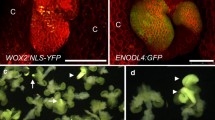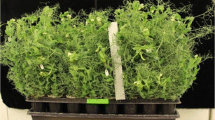Abstract
We propose herein a novel single seed descent protocol that has application across a broad phenotypic range of pea genotypes. Manipulation of key in vivo growing conditions, including light, photoperiod and temperature, combined with precocious in vitro germination of the embryo at full physiological maturity substantially shortened the pea lifecycle. We define full embryo physiological maturity as the earliest point in seed development when precocious in vitro germination and robust seedling growth can be reliably achieved without supply of exogenous hormones. Under our optimised conditions for accelerated plant growth, embryo physiological maturity was attained at c. 18 days after pollination, when seed moisture content was below 60 % and sucrose level under 100 mg g−1 DW. No delay penalty in terms of time to flowering and plant development was caused by the culture of immature seeds 18 days after pollination compared to the used of mature ones. Determining the role embryo maturity plays in the fitness of the germinated plant has facilitated the truncation of the lifecycle across pea genotypes. The accelerated single seed descent system proposed within this research will benefit complex genetic studies via the rapid development of recombinant inbred lines (RIL) and multi-parental advanced generation intercrosses (MAGIC) populations.



Similar content being viewed by others
References
Brim CA (1966) A modified pedigree method of selection in soybeans. Crop Sci 6:220
Cavanagh C, Morell M, Mackay I, Powell W (2008) From mutations to MAGIC: resources for gene discovery, validation and delivery in crop plants. Curr Opin Plant Biol 11:215–221
Cerdan PD, Chory J (2003) Regulation of flowering time by light quality. Nature 423:881–885
Croser JS, Lulsdorf MM, Davies PA, Clarke HJ, Bayliss KL, Mallikarjuna N, Siddique KHM (2006) Toward doubled haploid production in the Fabaceae: progress, constraints, and opportunities. Crit Rev Plant Sci 25:139–157
Cummings IG, Reid JB, Koutoulis A (2007) Red to far-red ratio correction in plant growth chambers—growth responses and influence of thermal load on garden pea. Physiol Plantarum 131:171–179
Ellis RH, Hong TD, Roberts EH (1987) The development of desiccation-tolerance and maximum seed quality during seed maturation in six grain legumes. Ann Bot 59:23–29
Franklin G, Pius PK, Ignacimuthu S (2000) Factors affecting in vitro flowering and fruiting of green pea (Pisum sativum L.) Euphytica 115:65–74
Gallardo K, Le Signor C, Vandekerckhove J, Thompson RD, Burstin J (2003) Proteomics of Medicago truncatula seed development establishes the time frame of diverse metabolic processes related to reserve accumulation. Plant Physiol 133:664–682
Gallardo K, Thompson R, Burstin J (2008) Reserve accumulation in legume seeds. CR Biol 331:755–762
Germanà MA (2011) Anther culture for haploid and doubled haploid production. Plant Cell Tiss Org Cult 104:283–300
Goulden CH (1939) Problems in plant selection. In: Burnett RC (ed) Proceeding of the Seventh Genetic Congress. Cambridge University Press, England, pp 132–133
Hay FR, Smith RD, Ellis RH, Butler LH (2010) Developmental changes in the germinability, desiccation tolerance, hardseededness, and longevity of individual seeds of Trifolium ambiguum. Ann Bot 105:1035–1052
Iannucci A, Terribile MR, Martiniello P (2008) Effects of temperature and photoperiod on flowering time of forage legumes in a Mediterranean environment. Field Crop Res 1006:156–162
Le Deunff Y, Rachidian Z (1988) Interruption of water delivery at physiological maturity is essential for seed development, germination and seedling growth in pea (Pisum sativum L.) J Exp Bot 39:1221–1230
Maluszynski M, Kasha KJ, Szarejko I (2003) Published doubled haploid protocols in plant species. In: Maluszynski M, Kasha KJ, Forster BP, Szarejko I (eds) Doubled haploid production in crop plants. A manual. Kluwer, Dordrecht, pp 309–335
Mason MG, Ross JJ, Babst BA, Wienclaw BN, Beveridge CA (2014) Sugar demand, not auxin, is the initial regulator of apical dominance. Proc Natl Acad Sci 111:6092–6097
Moe R, Heins R (1990) Control of plant morphogenesis and flowering by light quality and temperature. Acta Hortic 272:81–89
Murashige T, Skoog F (1962) A revised medium for rapid growth and bio assays with tobacco tissue cultures. Physiol Plantarum 15:473–497
Murfet IC, Reid JB (1974) Flowering in Pisum: the influence of photoperiod and vernalising temperatures on the expression of genes Lf and Sn. Z Pflanzenphysiol 71:323–331
Nelson MN, Berger JD, Erskine W (2010) Flowering time control in annual legumes: prospects in a changing global climate. CAB Rev: Perspect Agr Vet Sci Nutr Natur Resour 5:49–62
Noguero M, Atif RM, Ochatt S, Thompson RD (2013) The role of the DNA-binding One Zinc Finger (DOF) transcription factor family in plants. Plant Sci 209:32–45
Ochatt SJ (2015) Agroecological impact of an in vitro biotechnology approach of embryo development and seed filling in legumes. Agron Sustain Dev 35:535–552
Ochatt SJ, Sangwan RS (2010) In vitro flowering and seed set: acceleration of generation cycles. In: Davey MR, Anthony P (eds) Plant cell culture: essential methods. John Wiley & Sons, Ltd., Chichester, pp 97–110
Ochatt SJ, Sangwan RS, Marget P, Ndong YA, Rancillac M, Perney P (2002) New approaches towards the shortening of generation cycles for faster breeding of protein legumes. Plant Breeding 121:436–440
Redden B, Leonforte T, Ford R, Croser J, Slattery J (2005) Pea (Pisum sativum L.). In: Singh RJ, Jauhar PP (eds) Genetic resources, chromosome engineering, and crop improvement, vol 1. Taylor & Francis, Boca Raton, pp 49–83
Ribalta FM, Croser JS, Erskine W, Finnegan PM, Lulsdorf MM, Ochatt SJ (2014) Antigibberellin-induced reduction of internode length favors in vitro flowering and seed-set in different pea genotypes. Biol Plant 58:39–46
Runkle ES, Heins RD (2001) Specific functions of red, far red, and blue light in flowering and stem extension of long-day plants. J Amer Soc Hort Sci 126:275–282
Spalding EP, Folta KM (2005) Illumination topics in plant photobiology. Plant Cell Environ 28:39–53
Sultan SE (2000) Phenotypic plasticity for plant development, function and life history. Trends Plant Sci 5:537–542
Summerfield RJ, Roberts EH, Erskine W, Ellis RH (1985) Effects of temperature and photoperiod on flowering in lentils (Lens culinaris Medic.) Ann Bot 56:659–671
Udomdee W, Wen PJ, Lee CY, Chin SW, Chen FC (2014) Effect of sucrose concentration and seed maturity on in vitro germination of Dendrobium nobile hybrids. Plant Growth Regul 72:249–255
Vadez V, Berger JD, Warkentin T, Asseng S, Ratnakumar P, Rao KP, Gaur P, Munier-Jolain N, Larmure A, Voisin A-S, Sharma H, Pande S, Sharma M, Krishnamurthy L, Zaman M (2012) Adaptation of grain legumes to climate change: a review. Agron Sustain Dev 32:31–44
Valipour M, Ahmadi MZ, Raeini-Sarjaz M, Sefidkouhi MAG, Shahnazari A, Fazlola R, Darzi-Naftchali A (2015) Agricultural water management in the world during past half century. Arc Agron Soil Sci 61:657–678
Vince-Prue D (1981) Daylight and photoperiodism. In: Smith H (ed) Plants and the daylight spectrum. Academic Press Inc., London, pp 223–242
Weber H, Heim U, Golombek S, Borisjuk L, Manteuffel R, Wobus U (1998) Expression of a yeast-derived invertase in developing cotyledons of Vicia narbonensis alters the carbohydrate state and affects storage functions. Plant J 16:163–172
Weber H, Borisjuk L, Wobus U (2005) Molecular physiology of legume seed development. Annu Rev Plant Biol 56:253–279
Weller JL, Murfet IC, Reid JB (1997) Pea mutants with reduced sensitivity to far-red light define an important role for phytochrome A in day-length detection. Plant Physiol 114:1225–1236
Zhang J, Lechowicz MJ (1994) Correlation between time of fowering and phenotypic plasticity in Arabidopsis thaliana (Brassicaceae). Am J Bot 81:1336–1342
Zhou Y, Singh BR (2002) Red light stimulates flowering and anthocyanin biosynthesis in American cranberry. Plant Growth Regul 38:165–171
Acknowledgments
This work was supported by the Grains Research and Development Corporation [UWA00159]. We thank Mr. R. Creasy, Mr B. Piasini and Mr. L. Hodgson for glasshouse expertise and Dr Tony Leonforte (pea breeder, Pulse Breeding Australia) for assisting in germplasm selection and seed supply.
Author information
Authors and Affiliations
Corresponding author
Rights and permissions
About this article
Cite this article
Ribalta, F.M., Pazos-Navarro, M., Nelson, K. et al. Precocious floral initiation and identification of exact timing of embryo physiological maturity facilitate germination of immature seeds to truncate the lifecycle of pea. Plant Growth Regul 81, 345–353 (2017). https://doi.org/10.1007/s10725-016-0211-x
Received:
Accepted:
Published:
Issue Date:
DOI: https://doi.org/10.1007/s10725-016-0211-x




